2020 Update — Originally Published August 2014
This has been driving me crazy for a few years now, as I’ve really been trying to cultivate the most beautiful lawn possible. You can call it pride, or maybe you’ll want to say it’s a “guy thing,” but when I come home from work at the end of the day – I love turning the corner and pulling up to a pristine, meticulous and inviting home. And a lush, green front lawn is surely a huge part of every home’s appeal!
I came so close to getting it right this year, but if I’m to be perfectly honest – I blew it again. But I really think I have my solution now, and it’s this: Apply high quality lawn fungicide proactively. 4 Times a season. Starting in April – long before any significant lawn damage [like this] can take hold…
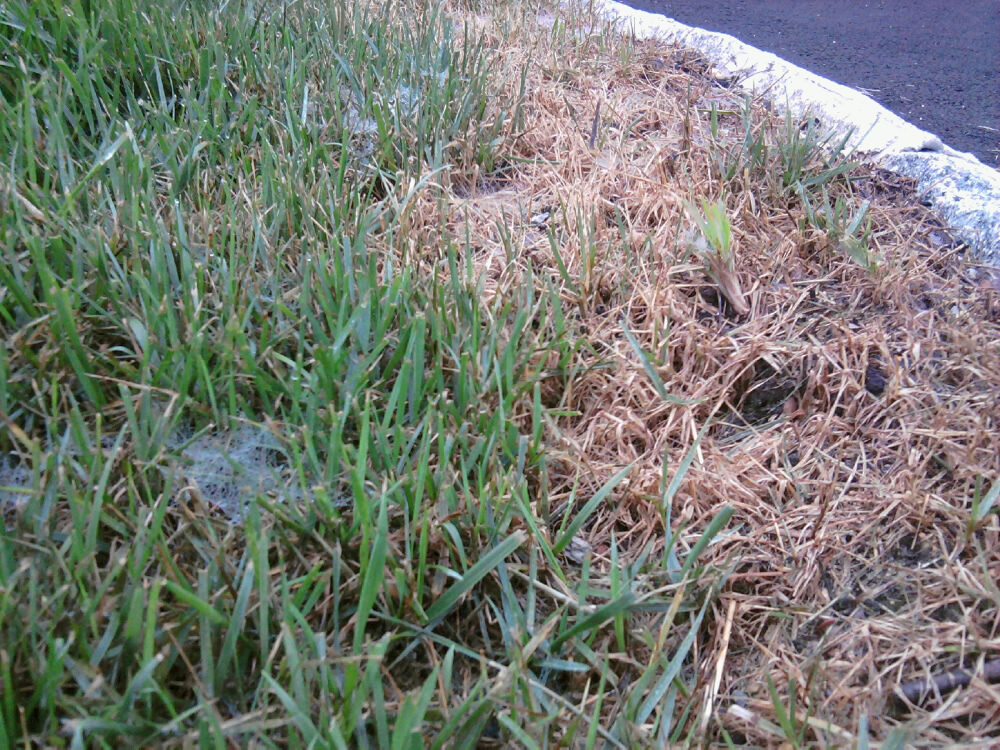
That’s not a typo: proactive fungicide applications starting in April.
All the details with many more personal photos (like my miserable, nasty, disgusting one above), now follow…
Lawn Maintenance: Striving for Perfect Grass
It’s been the same déjà vu experience at least four or five times now: I start out the spring with a gorgeous lawn – thick and emerald green. But as soon as we approach July, I start losing patches of grass in pretty much the same areas. Now, just to fill in some additional detail here – I’ve been applying fertilizer, lime, weed control and insect control on a regimented schedule which I also supplement with additional “tunes” as necessary. I’ve been spot-seeding every fall and I aerate every couple of years as well. I have sprinklers for the dry weather – and I’ve been taking some serious pain in the “water bill” to indulge my perfect-front-lawn aspiration.
Below are two photos of some of my lawn areas from this May. The first is the front lawn in full sun. The second is an area adjacent to my driveway later in the afternoon. I’m very happy with these…
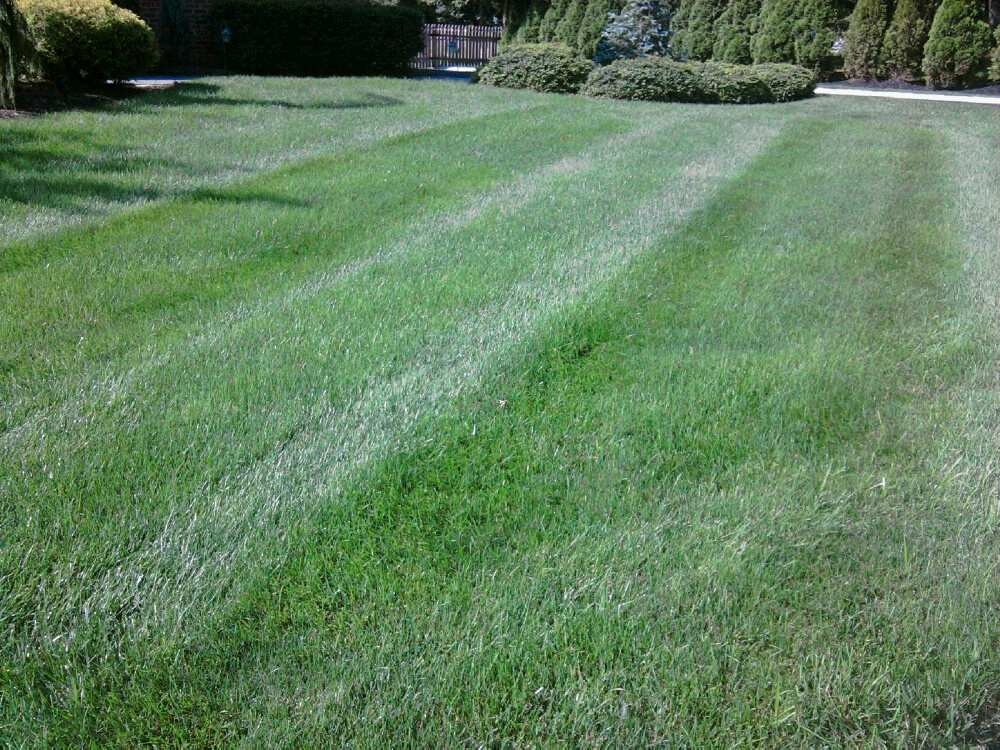
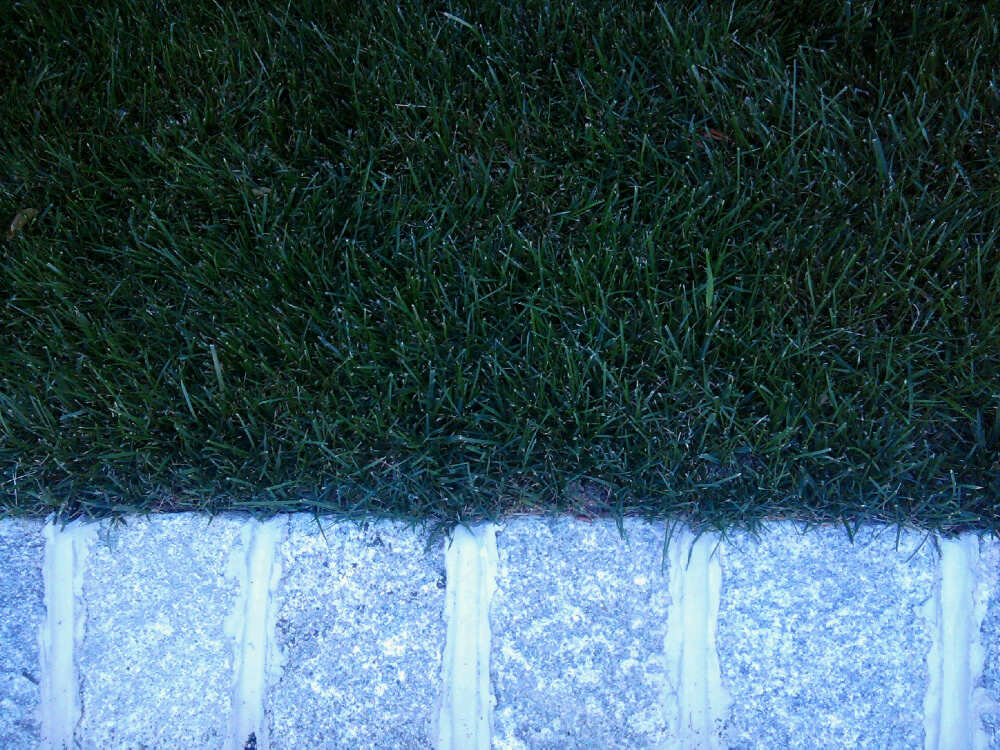
But then – seemingly out of nowhere, and for no obvious reason (though some of the reasons I will certainly explain soon), it’s mid-June and the areas near the driveway start to crash.
The shots that follow were taken just a few days ago…
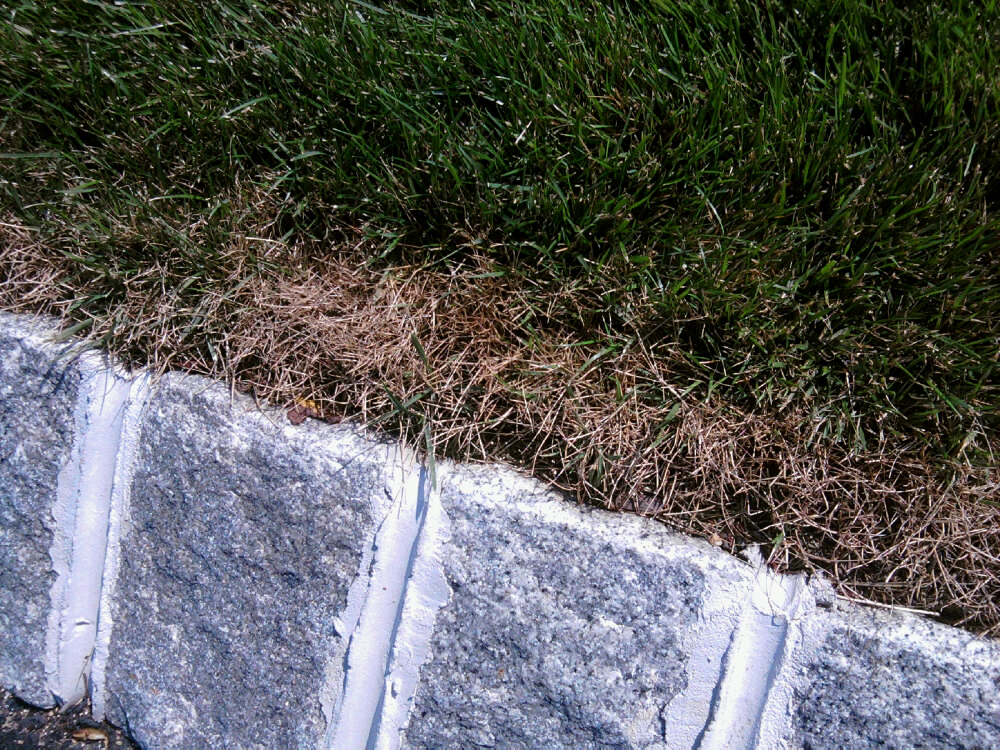
Is it insect damage?
Is a neighborhood dog using my grass to relieve himself?
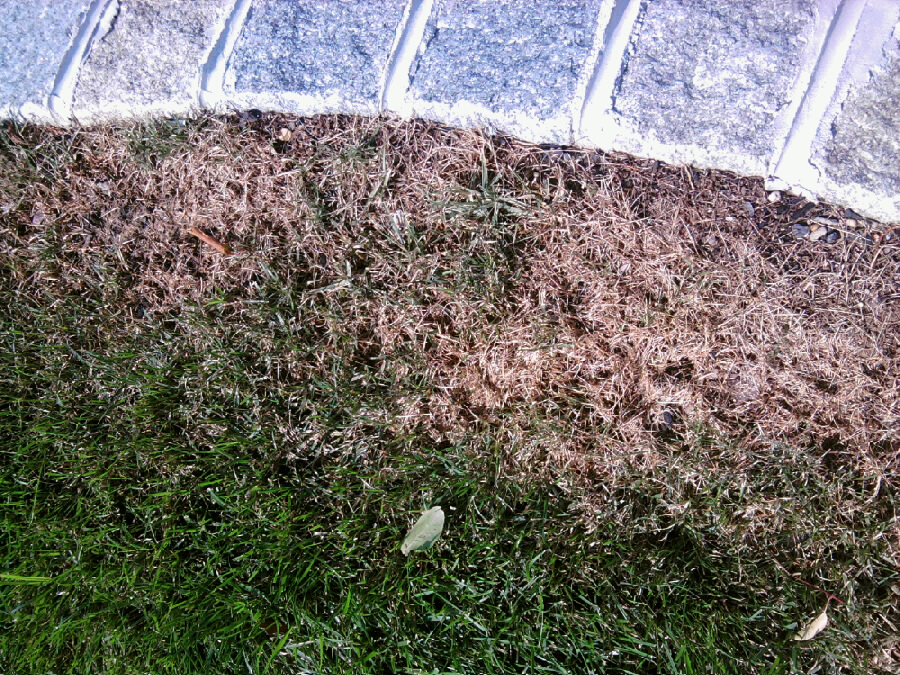
I wasn’t really sure initially – though both of these could certainly damage a lawn.
A Call for Help: My Local Lawn Service
After the third year of this repeating pattern, I called Scott’s Lawn Service to come out for a consultation. I had been using them for a while for basic fertilizing and grub control applications, and I was really worried that this could be a localized grub problem. (Grubs can devastate an entire lawn in short-order.) In my experience, Scotts has always been particularly good when it comes to consultation. If you have even a basic service with them, they will happily send someone out free of charge to assess any problem you report. I met with them and was informed of two things:
1) Dogs were indeed using my lawn for a bathroom down by the street and sidewalk – this was leading to circular brown patches from the dog urine.
2) The areas by the driveway, though, were suffering from a specific lawn fungus which could easily spread significantly given the right conditions.
So, How Does One Diagnose Lawn Problems?
This is a little tricky…
First off, just because there are brown spots in your lawn – it doesn’t necessarily mean you have a grass fungus. So before we go any further on that front, some of the other common causes for brown spots could be: insufficient watering, close mowing, dog urine, insects and possibly even periods of excessively high temperatures.
When it comes to lawn fungi, though, there are a number of varieties. If you want to read some excellent and detailed summaries of all kinds of lawn diseases/fungi you might have to deal with, check out the North Dakota State University summary of lawn diseases. There’s also a nice general lawn problem diagnostic tool I found in my research on the Consumer Reports web site.
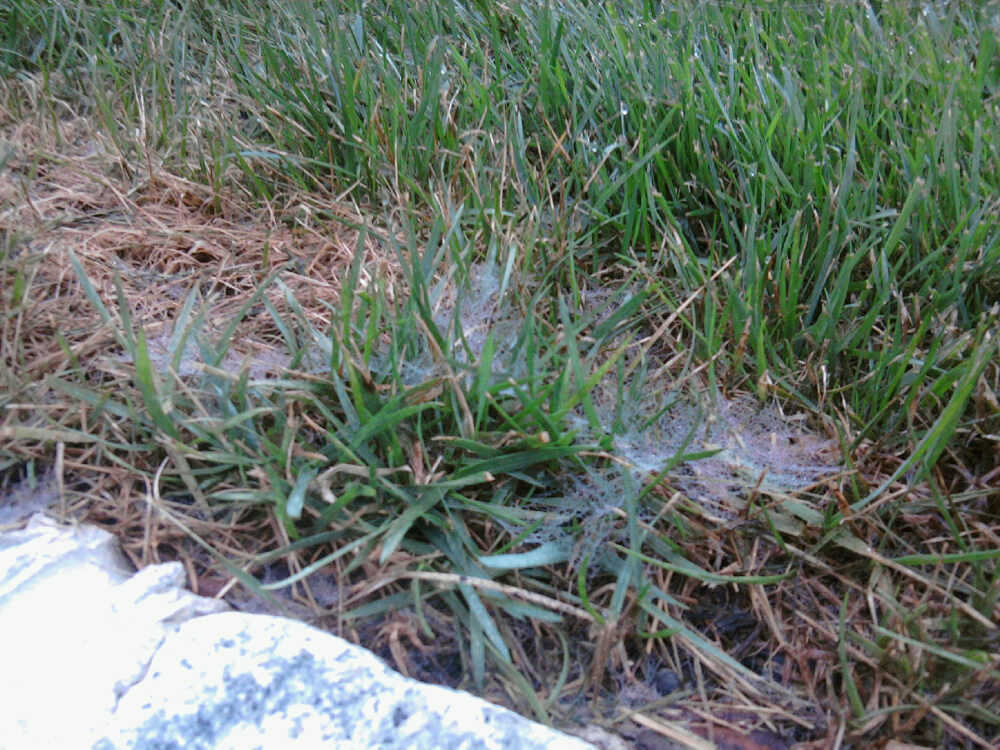
According to Scotts, the two most common lawn fungi varieties that seem to impact my geographic area are called brown patch and dollar spot. And the fungus that’s been repeatedly attacking my lawn, which is comprised primarily of fescues and bluegrass, is dollar spot: that’s what you’re seeing in the photos in this article.
When Scotts was with me, they asked if I had ever noticed any fine webbing on the damaged areas of my lawn in the early morning hours. I hadn’t. Until one overcast, misty morning as I was leaving for work… I saw (and photographed) what you now see here.
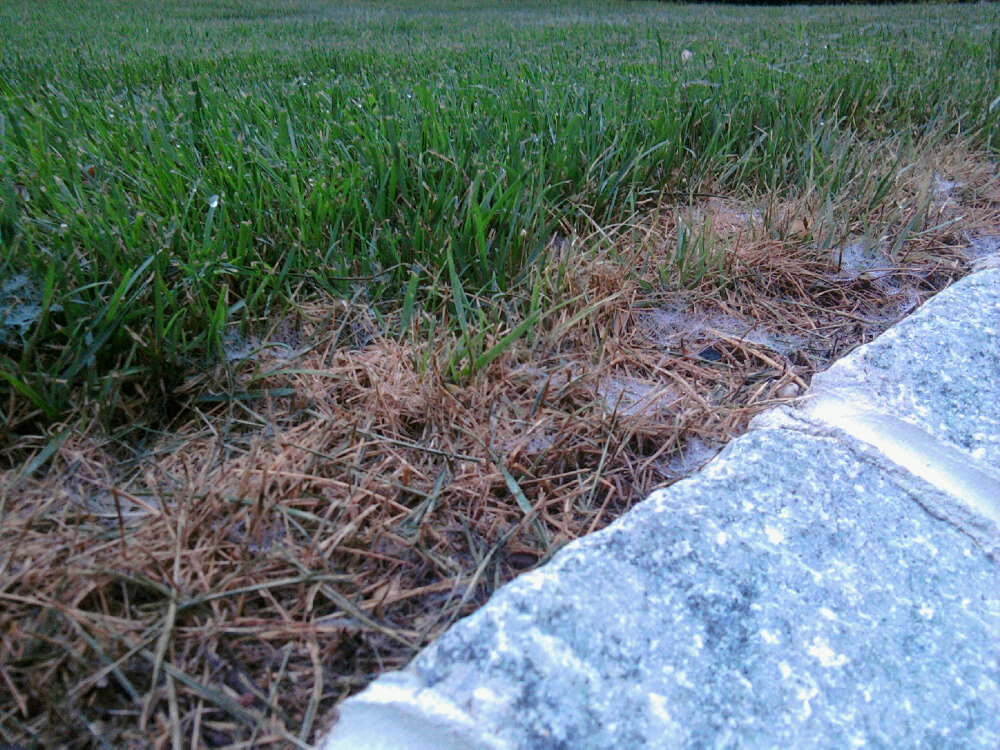
Look very closely at both photos above and be sure to click on the images to see the finest details.
So, there was no question. I had a lawn fungus – and I now knew exactly the variety. This particular fungus starts by hitting the individual blades in banded areas as shown just below. Eventually, the entire blade thins and turns brown. And given the right conditions, the fungus can thrive and spread much further into your lawn.
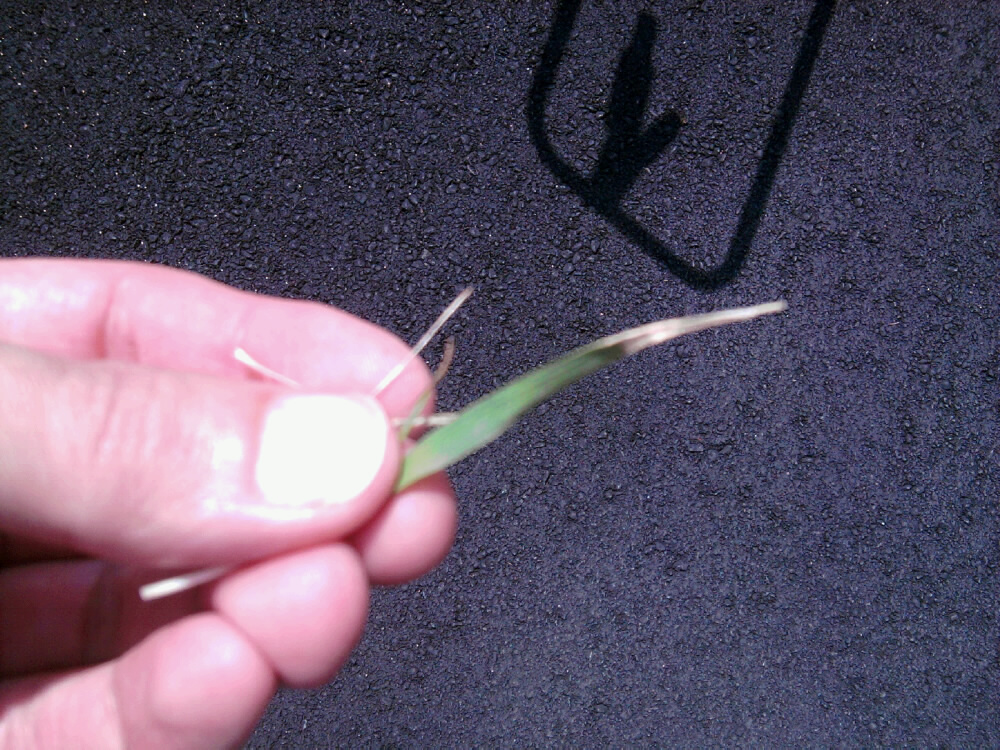
What Causes the Lawn Fungus to Thrive?
There are a few basic rules/facts on which everyone seems to agree:
- You don’t want your lawn to be wet at night if it can be avoided. Thus never water your lawn in the evening. Fungi (like mushrooms) thrive in the dark and when moist.
- Periods of excessive rainfall will increase the likelihood of developing a lawn fungus.
- With ongoing heavy rains or excessive evening watering, small localized areas of fungus-infected brown lawn can increase in size as the fungus spreads – and it’s entirely possible to have much/most of your lawn turn brown by the middle of summer.
Lawn Fungus Control: How Do We Get Rid of This?
The bad news is that if you see it, it’s most likely too late to get your perfect lawn back – it’s probably going to be there for the season.
Lawn Fungus Control Rule 1: Proactive Fungicide
Lawn Fungus treatment must be proactive and preventative – ideally before any indication of damage.
And this is where I “blew it” again this year. I didn’t expect it to appear so early. I missed my opportunity to stop it before it took hold. I should have started preventative fungicide treatments in late April or perhaps early May. (And yes – that’s an Amazon link right there… to LOTS of options.) I was so busy admiring how awesome my lawn looked, that I slipped up. For now, though, the best I can do is take action to strive to ensure in doesn’t spread too much further.
Lawn Fungus Control Rule 2: Water at Dawn
Yup – water your lawn at dawn.This one should be quite clear form the comments made in the earlier section: nighttime watering is surely to be avoided. Now, if it rains at night – there’s not much you can do, of course. But don’t catalyze the “mushroom effect” by watering at night. Dawn watering also tends to minimize evaporation, thus giving your grass excellent hydration and stamina for dealing with the additional stresses imposed by intense summer heat.
Lawn Fungus Control Rule 3: Be Meticulous
Find the right treatment for your particular situation and follow directions meticulously.
Find out what kind of grass you have – I know mine as I seeded every square foot with a slit seeder from the get-go. (As a side comment, this is a very fun and highly effective approach if you ever want to start a lawn from scratch: consider renting a slit seeder.)
If you’re not sure of your lawn make-up, rip a handful of blades out and take them with you to a nursery or, even better, get a reputable lawn service contractor to come to your home. You really want to consult with a professional on this as there are many fungi varieties which will further vary by geographic area. First-hand observation at your home is by far the best way to go, in my opinion.
Lawn Fungus Control Rule 4: Treat Repeatedly
Treat repeatedly throughout the season – again giving careful (meticulous) attention to the application directions.
I’ve come to apply lawn fungicide every 2-3 weeks with a broadcast spreader throughout the summer. This seems to work well for me as I haven’t had any massive spreading since I started doing this. I would surely, however, consult with a professional on the application frequency for your specific case as well. For example, the fungicide I’ve been using for the past 2 years says quite explicitly, “Maximum number of applications is four per year.” The folks at Scotts also recommended four applications for my property.
I buy my fungicide once for the season so I don’t have to keep worrying about it every few weeks. And I tend to stick with Scotts products for my lawn. But I wouldn’t hesitate to use anything from a credible, known manufacturer.
Here, once more, is a link to numerous lawn fungicide options on Amazon. There are lots of reviews for each option.
Applying the treatment takes about 10-15 minutes for my front lawn.
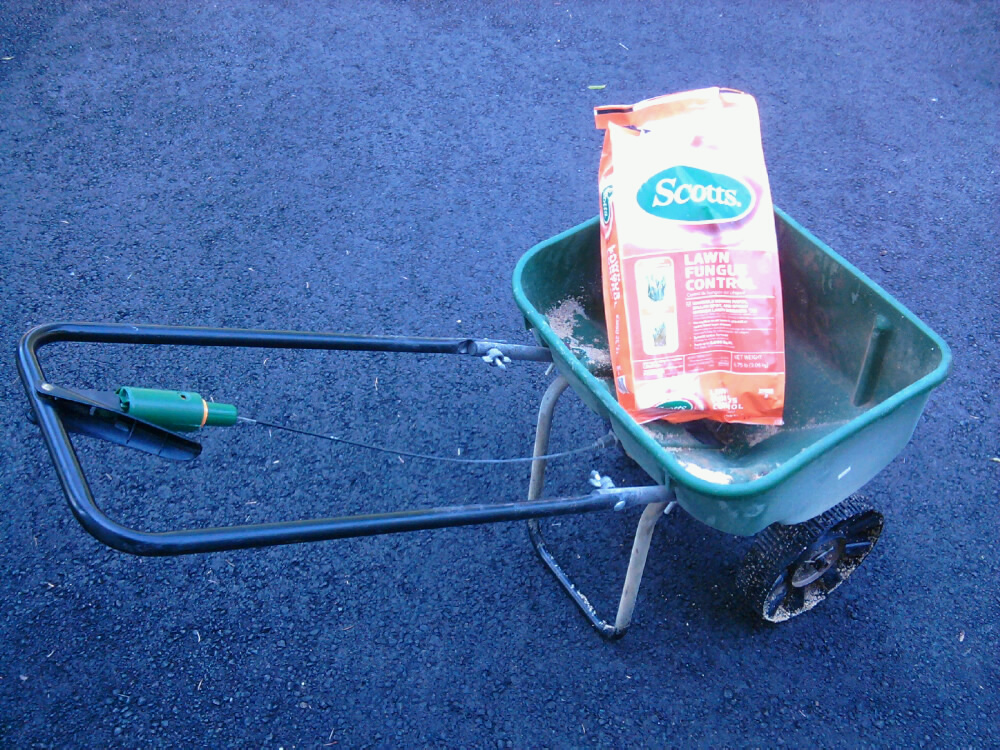
And Thinking Forward to Next Year…
I now start my fungicide treatments in April. Period. Because even if you go with the sexist “it’s a guy thing” comment about wanting an awesome front lawn, one thing is for sure: I do.
And if anyone can give me any tips for ways to keep neighborhood dogs from using my lawn as a bathroom, I’d sure love to hear those! Anyone??
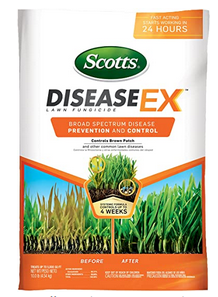

Scotts lawn products are amazing. Personally, I use Scotts fertilizers and they work awesome. Glad to hear that you have solved problems with your lawn!
I totally agree, Maria – It’s not that there aren’t other good products out there as well, but I’ve always had great experiences with Scotts, and that’s why I mention them explicitly. I’ll also say that I haven’t exactly solved my lawn problem as I simply live in a wet, humid area – where fungus will always be an issue, unfortunately. But I definitely know how to control it now, and until I move – that’s the best I can do!